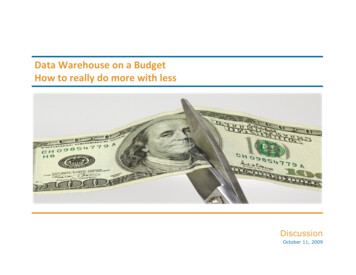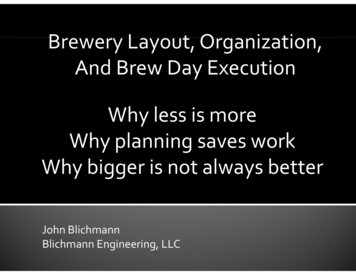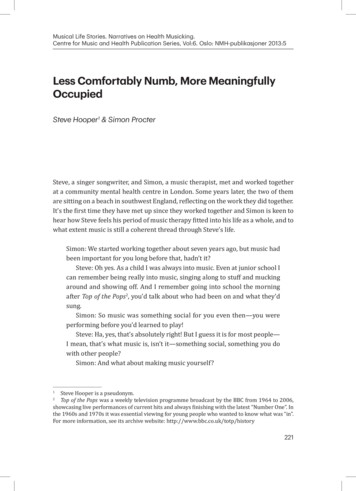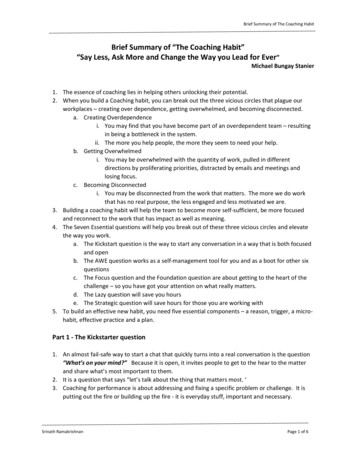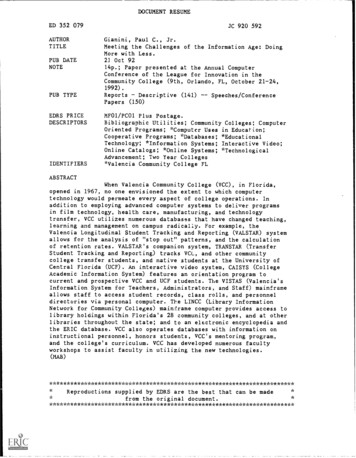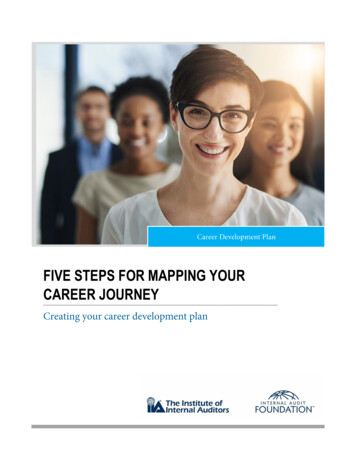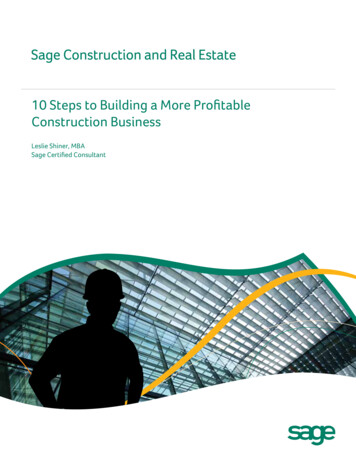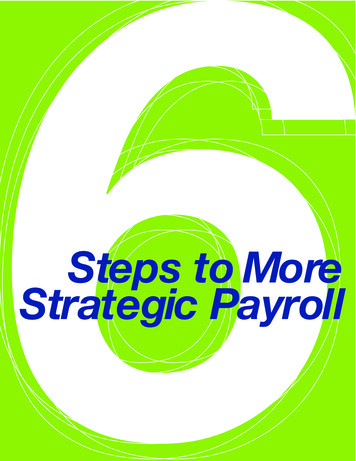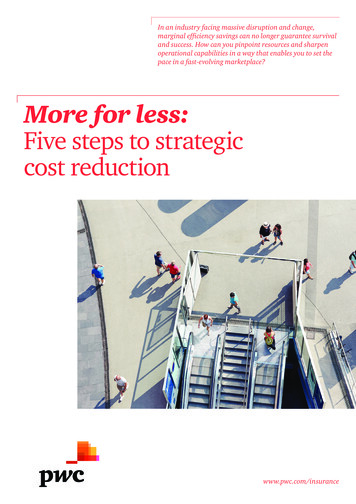
Transcription
In an industry facing massive disruption and change,marginal efficiency savings can no longer guarantee survivaland success. How can you pinpoint resources and sharpenoperational capabilities in a way that enables you to set thepace in a fast-evolving marketplace?More for less:Five steps to strategiccost reductionwww.pwc.com/insurance
2 PwC More for less: Five steps to strategic cost reductionContentsIntroduction:3Rethinking strategy and cost5The way forward8Conclusion:Key questions for your organisation12Our approach13Contacts14
More for less: Five steps to strategic cost reduction PwC 3IntroductionInsurance CEOs recognise the scale of the disruption withintheir industry1, which is creating opportunities for some,and threats for others.Yet, squeezing a few percentage pointsavings from slow, stretched andunfocused operations isn’t going to beenough to sustain competitive relevancein this disrupted marketplace. Theinsurers out in front have embarked on amuch more fundamental transformationin strategy and operational capabilities.They’re determined to get muchcloser to customers and many timesfaster, sharper and more innovative inresponding to their needs – what’s cometo be known as a ‘10X’ differential.This is an industry facing a perfect stormof soft rates, low investment yields andnew regulation. And by 2020, the impactof new technology, shifting customerexpectations and nimble InsurTechentrants means that prevailing businessmodels and the companies competing inthe market will look very different fromtoday.Tight margins have naturally heightenedthe focus on cost – 70% of the insurancebusiness leaders taking part in ourlatest Annual Global CEO Survey planto implement a cost reduction initiativeover the coming year, more than anyother financial services sector2.The crucial priority isn’t the costs youcut, rather where you focus resourcesto stimulate growth and differentiation– strategic cost reduction. This includesdigital transformation that can not onlysharpen the precision of risk selectionand pricing, but also deliver moretailored and targeted client solutionsat a fraction of the cost. And beyondtechnology are opportunities to refocusresources away from low returningbusiness towards higher value andhigher return opportunities, both infast growing geographical markets andunderinsured exposures such as cyberand environmental risks. Indeed, thekey differentiator within strategic costreduction isn’t technology so much asthe strategic ambition and underlyingculture of innovation and customer focuswithin the organisation.Five stepsThe problem is that many costoptimisation programmes struggle todeliver or fail to stick. However muchyou cut the costs, there are someproducts where the returns still won’tbe viable, either because customersdon’t value them or there is alwayssomeone else prepared to offer themcheaper – the primary focus should beon value potential rather than volumeor cost. We’re also at the point wherethe quick cost wins have been largelyaccomplished, leaving tougher and morestrategically far-reaching choices ahead.The hard wins are likely to includewithdrawal from unviable markets,significant shifts in business model andcomplete automation or even eliminationof certain processes.As we outline in this paper, making theright choices and moving the businessforward requires a rethink of strategy,costs and, most important of all, howthey align. The five steps we set out herefocus on optimising rather than justcutting expenses to ensure your businesscan sustain competitive relevance andmaximise its potential.1. Start with strategy: Have a clearview of your strategy and ensure it isconsistently understood across theorganisation.1 If we put the disruptive forces of change together, the only sector facing greater disruption than insurance is entertainment and media. Based on responses to PwC19th Annual Global CEO Survey (2016) ‘Seizing the future’ (www.pwc.com/ceoinsurance). Disruption defined as significant CEO concerns over overregulation, newmarket entrants, the speed of technological change and shifts in consumer spending and behaviour (www.pwc.com/ceosurvey)2 101 insurance CEOs were interviewed for the PwC 19th Annual Global CEO Survey (2016) ‘Seizing the future’ (www.pwc.com/ceoinsurance)
4 PwC More for less: Five steps to strategic cost reduction2. Align costs to strategy: Look acrossthe whole organisation and differentiatethe strategically-critical ‘good costs’ fromthe non-essential ‘bad costs’.3. Aim high: Be bold, be brave and becreative – use technology, innovationand new ways of working to radicallyoptimise the cost base.4. Set direction and show leadership:Deliver cost optimisation as a strategic,business transformation programme.5. Create a culture of costoptimisation: Ensure you embed aculture of ownership and incentivisecontinuous improvement.There are huge top and bottom linerewards for getting this right. Yourbusiness will be more differentiated andequipped to deliver on its objectives.You’ll also be less reliant on pricing tocompete in the market as resourcesare targeted at high earning growthbusiness. Without this clear sense ofwhat costs to keep and what ones toeliminate, you run the risk of being leftbehind.Stephen O’HearnGlobal Insurance Leader, PwCGood costs and bad costsThe key priority in strategic cost reduction is targeting resources where theycan earn the best return, rather than just cutting costs in itself.The starting point is differentiating the capabilities needed to fuel profitablegrowth (‘good costs’ targeted for investment) from low-performing businessand inefficient operations (‘bad costs’ targeted for overhaul or elimination).Good costs are capabilities that differentiate your business, move it closer tocustomers, and enable it to develop new value propositions. Determining andfocusing on what really matters to customers in today’s market.Bad costs are non-essential areas of spending.10X: Aiming higher10X, a concept pioneered in the digital and InsurTech sectors, looks beyondmarginal efficiency savings at how to achieve a game-changing boost incapabilities. Improving efficiency by a few percentage points means that you’reprobably doing what you’ve always done, just a little better, and all your peersare likely to be doing much the same. A 10x improvement enables you toreshape customer expectations and set the competitive bar for others to follow.
More for less: Five steps to strategic cost reduction PwC 5Rethinking strategy and costDelivering strategic change and putting in place theoperational capabilities needed to deliver it have alwaysbeen difficult. Yet, we now have both the compelling driversand the practical means to make strategic cost reductionrealisable and transformational.Many of you will have had bruisingexperience of cost initiatives that havefailed to deliver lasting gains. Why is thissuch a difficult challenge? All too often,ambitions aren’t set high enough on theone side and the difficulties of executionare under-estimated on the other. Thisis especially so now that we’re movingfrom the quick win to hard gain phase ofstrategic cost reduction.The underlying challenges includeresistance from the organisation. Thisencourages boards to cut a little fromeach division as a politically acceptableway to share the pain, rather thanlooking at where resources could be bestdeployed or the underlying reasons whycosts in some areas are needlessly high.Lack of buy-in can be compounded bythe hurdles of operational complexityand a lack of direction, accountabilityand dedicated resources allocated to costinitiatives.Now, however, accelerating disruptionhas created the burning platform fortransformation in both strategy and cost(see Figure 1). And the current marketalso offers the technology and openingsfor innovation needed to cut throughcomplexity and transform operationalcapabilities.Figure 1: Burning platform for a rethink of strategy and cost70%RegulationIncreased capital requirements,compliance costs and intrusivescrutiny of conductFinTechTechnology is providinginsurers with new ways ofworking and significant costreduction which providescompetitive advantage.Insurance CEOs planning a majorcost restructure in 20163XIncrease in global M&A activityin 2015–16: driving integrationInsuranceindustry0%Market conditionsContinued declining rates,poor investment returnscombined with expensepressure create a challengingenvironment to underwriteprofitably.Source: PwC analysisCustomer expectationsDemanding consumers withhigher expectations of serviceand value. ‘Digital natives’ expectquick and easy access to betterproducts and information. Thistrend also raises the bar for B2Brelationships with corporate,affinity and broker markets.Virtually zero investment returns aredriving optimisation of the cost base
6 PwC More for less: Five steps to strategic cost reductionCase study – Saving to grow3ChallengeGroup decided that many of the areas of highest cost were not adding competitive advantage and chose to pass these on toa third party provider. It wanted a partner that could not only deliver efficiency savings, but also help support its drive intomobile distribution.SolutionUndertook a significant programme of strategic outsourcing, using a partner to provide technology and business operationsand upgrade robotics and data analytics capabilities.OutcomeReleased hundreds of millions of dollars of cost, which the group invested in creating new digital propositions and buildingstrong customer relationships.Sorting the good costs fromthe badthe basis for keener pricing and reducedclaims costs.The key to realising this opportunity ismaking sure that maximum resourcesare targeted at the drivers of profitablegrowth (good costs), while freeing upand minimising bad costs. So what arethe good costs and bad costs in this fastchanging market and what marks outthe insurers and reinsurers who are outin front?2. Transactional processes1. DistributionBad costBad costUnderwriting, claims and finance arelittered with low value transactionalprocesses and wasted costs (inunderwriting, for example, up to80% of the sales time can be spent onadministration). These processes oftenrely on heavy manual workarounds,including re-inputting of informationonto multiple systems.Distribution and policy originationare needlessly costly, a problemcompounded by poorly targetedmarketing and low conversion rateswithin many businesses. The expense ofdistribution within insurance can be ashigh as 30% of the cost of the product.This isn’t sustainable over the long-term.Good costGood costDigitising claims: A new generationof monitors and apps can allowpolicyholders to initiate a claiminstantaneously, making it easierfor policyholders and speeding upprocessing. In a car accident, forexample, the in-car sensor could recordthe speed and direction of travel, whilea photo texted from the scene wouldshow the damage and get repair andsettlement lined up straight away.Technology is also strengthening fraudprevention and detection as behavioural,pattern recognition and other fastSharpening customisation andconversion: The businesses out in frontare using machine learning, advancedanalytics and sensor technologies totarget clients, evaluate their needs,develop fully bespoke solutions andprice risk in real-time. The strategiccost benefits include more focused salesand marketing investments and morefavourable outcomes for policyholders– products are bought not sold. Thegreater precision in risk selection andcustomer customisation can also provideRobotics: Front-runners are moving torobotic process automation (RPA) andstraight-through-processing (STP). AsFigure 2 highlights, robotics have alreadybeen proven to deliver significant savingsover ‘old style’ onshore and offshoresolutions.3 http://www.csc.com/insurance/success stories/104821-metlife modernizes a traditional business4 We explore the potential further in ‘Blockchain: The 5 billion opportunity for loping analytical techniques enableinsurers to quickly scan for peoplewho may be likely to commit fraudand identify suspicious claims. Furtherdevelopments include predictive models,which can set benchmarks for how mucha batch of similar claims should cost.It’s then possible to compare the resultsagainst actual experience to detect signsof leakage and tackle the causes.Sharpening underwriting: Automationand artificial intelligence are alreadycutting costs by speeding up routineunderwriting and providing a moreinformed basis for pricing and lossevaluation. The emerging opportunitiesinclude using tracking data in areasranging from equipment sensors to theGPS transponders on container ships tooffer real-time risk monitoring, pricingand protection. Advances in cognitivecomputing also allow you to movefrom analysing what’s happened toanticipating what will happen and when(predictive analytics) and proactivelyshaping the outcome (prescriptiveanalytics).Blockchain: Blockchain applicationscan cut processing time and cost ofplacement and KYC/AML. They couldalso speed up decisions over claims andimprove customer experienceIn reinsurance, we believe thatblockchain could reduce expenses by15%-25% of expenses ( 5- 10 billionindustry-wide)4.
More for less: Five steps to strategic cost reduction PwC 7Figure 2: The robotics potentialResults found by using software robotics100%HighCase study – Cuttingthrough to what countsCosts33%11%LowOnshore full timeequivalent (FTE)Offshore full timeequivalent (FTE)RobotOperational benefitsLower costs/riskManagement informationNon invasiveWork performed on demandScalableIntegration with Artificial intelligence3. Property4. Service providersBad costBad costFrom head offices to back offices, manyinsurers are spending far more than theyneed on property: having static, flag-shipoffices where employees spend hourscommuting to sit at a prescribed desk.Third party service spending largelyfails to reflect t
Rethinking strategy and cost 5 The way forward 8 Conclusion:12 Key questions for your organisation Our approach 13 Contacts14 . More for less: Five steps to strategic cost reduction PwC 3 This is an industry facing a perfect storm of soft rates, low investment yields and new regulation. And by 2020, the impact of new technology, shifting customer expectations and nimble InsurTech entrants .
